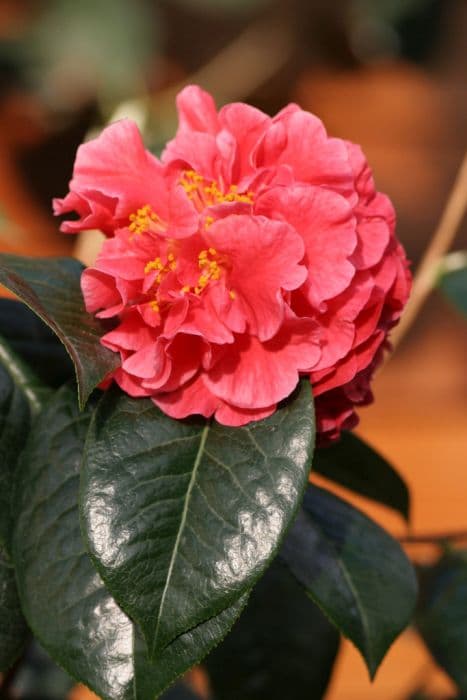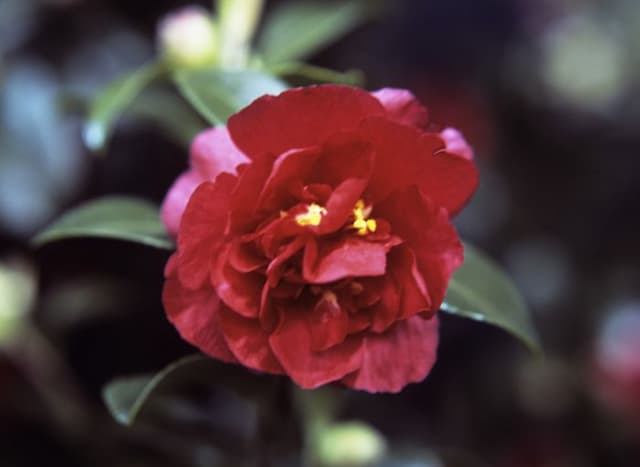Williamsii Camellia Camellia × williamsii 'Saint Ewe'

ABOUT
The Camellia 'Saint Ewe' is an ornamental plant renowned for its beautiful display. It features glossy, dark green leaves that provide a lustrous backdrop throughout the year. The true spectacle of this plant lies in its blossoms; it produces large, peony-like flowers. These blooms display a captivating rose-pink hue, which can vary in intensity, sometimes presenting subtle variations in color across different flowers or even within a single bloom. The petals are arranged in a dense, luxurious formation, often exhibiting a slightly ruffled edge that adds to their charm. The flowers emanate a delicate, alluring fragrance that can attract pollinators and delight the senses on a calm day. In the center, a cluster of prominent golden stamens is typically visible, providing a striking contrast to the pink petals and enhancing the overall appeal of the flower. This plant stands as a staple in ornamental gardens, particularly prized for its stunning floral display, which can bring a touch of romantic elegance to the landscape.
About this plant
 Names
NamesFamily
Theaceae
Synonyms
Saint Ewe Camellia, Williamsii Camellia
Common names
Camellia × williamsii 'Saint Ewe'.
 Toxicity
ToxicityTo humans
Williamsii Camellias, including the 'Saint Ewe' variety, are generally considered non-toxic to humans. There is no widespread evidence that the plant poses a significant risk if ingested, and it is not associated with severe or life-threatening symptoms of poisoning. However, like with any plant material, individual allergic reactions or instances of gastrointestinal upset can occur, especially when plant parts are consumed in large quantities. It is always wise to exercise caution and avoid eating parts of ornamental plants not intended for human consumption.
To pets
Williamsii Camellias are also generally considered non-toxic to pets. The 'Saint Ewe' variety should not pose a significant risk to cats, dogs, or other household pets if they happen to ingest parts of the plant. Poisoning symptoms are unlikely, but some animals may experience mild gastrointestinal upset if they ingest large amounts of plant material. As with any non-food plant, pets should be discouraged from eating it, to avoid potential digestive issues.
 Characteristics
CharacteristicsLife cycle
Perennials
Foliage type
Evergreen
Color of leaves
Green
Flower color
Pink
Height
6-10 feet (1.8-3 meters)
Spread
6-10 feet (1.8-3 meters)
Plant type
Shrub
Hardiness zones
7
Native area
China Japan
Benefits
 General Benefits
General Benefits- Ornamental Value: The plant features attractive flowers that bloom in various shades, adding aesthetic appeal to gardens and landscapes.
- Long Blooming Period: Typically flowers from late autumn to early spring, providing color during seasons when few other plants bloom.
- Low Maintenance: Once established, it requires minimal upkeep, making it suitable for busy gardeners or those with limited gardening experience.
- Drought Tolerance: Once established, it can tolerate periods of dryness, reducing the need for frequent watering.
- Cold Resistance: It is relatively hardy against cold temperatures, making it suitable for temperate climates.
- Shade Tolerance: Can grow in partial shade, offering flexibility in landscaping areas with variable light conditions.
- Versatility: Suitable for a variety of garden styles, including formal, woodland, and cottage gardens.
- Evergreen Foliage: Provides year-round interest with its glossy, green leaves, even when not in bloom.
- Pollinator Friendly: Attracts bees and other pollinators, which are beneficial for the environment and garden health.
 Medical Properties
Medical PropertiesThis plant is not used for medical purposes.
 Air-purifying Qualities
Air-purifying QualitiesThis plant is not specifically known for air purifying qualities.
 Other Uses
Other Uses- Camellia williamsii 'Saint Ewe' petals can be candied or crystallized for decorative dessert garnishes, adding an elegant touch to cakes and pastries.
- The leaves of the Camellia williamsii 'Saint Ewe' can be used as a natural dye for fabrics, producing various shades of green and brown.
- Wood from the Camellia williamsii 'Saint Ewe' bush is hard and durable, suitable for crafting small wooden objects like handles and ornaments.
- Pressed flowers and leaves of Camellia williamsii 'Saint Ewe' can be incorporated into paper making, creating beautiful, textured handmade paper.
- Camellia williamsii 'Saint Ewe' can be grown as a living fence or privacy screen due to its dense foliage and growth habit.
- Dried Camellia williamsii 'Saint Ewe' flowers can be used in potpourris and sachets to provide a subtle floral scent to drawers and closets.
- The plant can feature in bonsai cultivation, providing an interesting challenge to grow Camellia williamsii 'Saint Ewe' in miniature form.
- Camellia williamsii 'Saint Ewe' branches can be used for floral arrangements, providing structure and supporting other flowers in the display.
- The seeds of Camellia williamsii 'Saint Ewe', although not commonly harvested, can be pressed to extract a limited quantity of oil for experimental or artistic use.
- Camellia williamsii 'Saint Ewe' can be used as a companion plant in gardens, helping to create microclimates or protect more delicate plants from wind or sun.
Interesting Facts
 Feng Shui
Feng ShuiThe Camellia is not used in Feng Shui practice.
 Zodiac Sign Compitability
Zodiac Sign CompitabilityThe Camellia is not used in astrology practice.
 Plant Symbolism
Plant Symbolism- Adoration and devotion - In the language of flowers, camellias often represent adoration, which can be attributed to their lush beauty and the way they are lovingly cultivated in gardens.
- Perfection and excellence - The perfection of the camellia's petals is frequently seen as a symbol of excellence, with its flawlessly arranged petals and glossy leaves.
- Longevity and steadfastness - Camellias are evergreen and can live for a long time, symbolizing both the longevity and steadfast nature of certain types of love or friendship.
- Affection and deep desire - The richness of the camellia bloom can be indicative of deep feelings of affection or a desire for someone.
- Admiration - The beauty and enduring qualities of the camellia also communicate admiration for someone's qualities.
 Water
WaterWilliamsii Camellias, like 'Saint Ewe', require thorough watering to keep the soil moist but not soggy. In general, water the plant once a week with about 1 to 1.5 gallons per session for a medium-sized shrub. During the growing season in spring and summer, water may be needed more often, especially in dry conditions. However, in the winter when the plant is dormant, reduce the watering frequency to every two weeks, assuming there is no significant rainfall. Always check the top couple of inches of soil for dryness before watering to avoid overwatering.
 Light
LightWilliamsii Camellias such as 'Saint Ewe' thrive in partial shade with dappled sunlight. They should be protected from harsh afternoon sun, which can scorch their leaves, so a spot that receives morning light and afternoon shade is ideal. An eastern-facing garden edge or a location under a canopy of lightly spaced taller trees would provide the best light conditions for healthy growth.
 Temperature
TemperatureWilliamsii Camellias, including 'Saint Ewe', are cold-hardy and can tolerate temperatures as low as 10°F. They thrive in a range of temperatures, but their ideal growing conditions are between 68°F and 72°F. They should be protected from extreme cold below 10°F and from hot temperatures above 85°F, which can stress the plant.
 Pruning
PruningWilliamsii Camellias such as 'Saint Ewe' should be pruned to maintain shape, remove dead or weak growth, and enhance air circulation. Pruning is best done just after blooming in spring to avoid cutting off next year's buds. Usually, once-a-year pruning is sufficient, focusing on thinning crowded branches and shortening overly long shoots.
 Cleaning
CleaningAs needed
 Soil
SoilThe Williamsii Camellia should be planted in well-draining, acidic soil with a pH of 5.5 to 6.5. A suitable mix would be one-third peat moss, one-third pine bark, and one-third perlite or coarse sand for drainage.
 Repotting
RepottingWilliamsii Camellias typically require repotting every 2-3 years to replenish the soil and provide room for growing roots, preferably in the spring after flowering.
 Humidity & Misting
Humidity & MistingWilliamsii Camellias thrive in high humidity environments, with best conditions around 50-60% relative humidity, which helps keep the foliage lush and healthy.
 Suitable locations
Suitable locationsIndoor
Place Williamsii Camellia in bright, indirect light, away from dry heat.
Outdoor
Plant Williamsii Camellia in partial shade, sheltered from strong winds.
Hardiness zone
7-9 USDA
 Life cycle
Life cycleCamellia × williamsii 'Saint Ewe', commonly known as the Williamsii camellia, begins its life cycle when the seed germinates, typically requiring a moist and well-draining soil environment with partial shade. As a seedling, the plant gradually establishes a root system and a small rosette of leaves. Progressing to the juvenile phase, the Williamsii camellia develops a more robust foliage canopy and starts to form its characteristic woody structure. During the adult phase, the plant reaches maturity and annually produces its large, showy flowers, typically in late winter to early spring, which can range in color from pink to white. After pollination, the flowers give way to seed-containing fruit, completing the reproductive cycle. Finally, as an established perennial shrub, the Williamsii camellia focuses on vegetative growth and maintenance of its evergreen leaves, while potentially living and flowering for several decades if provided with the right conditions.
 Propogation
PropogationPropogation time
Spring-Early Summer
Camellia × williamsii 'Saint Ewe', commonly known as Camellia, is most commonly propagated through semi-hardwood cuttings. This method is especially effective during the late summer months, when the plant's new growth from spring begins to firm up. Gardeners typically select healthy stems that are not yet fully hard, cuttings them at a length of about 4-6 inches (10-15 centimeters), making sure that each piece has several leaves. The lower leaves are removed, and the cut end is dipped in rooting hormone to facilitate the development of roots. The cuttings are then planted in a mixture of peat and perlite or in sterile potting soil, keeping them well-watered and under indirect light until roots form, which typically takes a few months. For best results, maintaining a humid environment by covering the cuttings with a plastic bag or placing them in a propagator can be beneficial.









